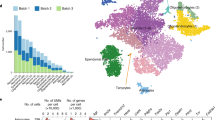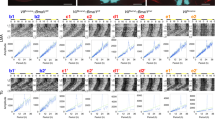Abstract
Daily biological rhythms are governed by an innate timekeeping mechanism, or ‘circadian clock’. In mammals, a clock in the suprachiasmatic nucleus (SCN) comprises multiple autonomous single-cell oscillators, but it is unclear how SCN cells interact to form a tissue with coherent metabolic and electrical rhythms that might account for circadian animal behaviors. Here we demonstrate that the circadian rhythm of SCN electrophysiological activity, recorded as a single daytime peak in hamster hypothalamic coronal slices, shows two distinct peaks when slices are cut in the horizontal plane. Substantiating an idea initially derived from behavioral observations, the properties of these two peaks indicate functional organization of SCN tissue as a clock with two oscillating components.
This is a preview of subscription content, access via your institution
Access options
Subscribe to this journal
Receive 12 print issues and online access
$209.00 per year
only $17.42 per issue
Buy this article
- Purchase on Springer Link
- Instant access to full article PDF
Prices may be subject to local taxes which are calculated during checkout




Similar content being viewed by others
References
Pittendrigh, C. S. & Daan, S. A functional analysis of circadian pacemakers in nocturnal rodents. V. Pacemaker structure: a clock for all seasons. J. Comp. Physiol. A 106, 333–355 (1976).
Daan, S. & Berde, C. Two coupled oscillators: simulations of the circadian pacemaker in mammalian activity rhythms. J. Theor. Biol. 70, 297–313 ( 1978).
Illnerová, H. & Vanĕc̆ek, J. Two-oscillator structure of the pacemaker controlling the circadian rhythm of N-acetyltransferase in the rat pineal gland. J. Comp. Physiol. A 145, 539–548 (1982).
Elliott, J. A. & Tamarkin, L. Complex circadian regulation of pineal melatonin and wheel-running in Syrian hamsters. J. Comp. Physiol. A 174, 469–484 (1994).
Honma, K., Honma, S. & Hiroshige, T. Response curve, free-running period, and activity time in circadian locomotor rhythm of rats. Jpn. J. Physiol. 35, 643–658 (1985).
Meijer, J. H. & DeVries, M. J. Light-induced phase shifts in onset and offset of running-wheel activity in the Syrian hamster. J. Biol. Rhythms 10, 4–16 (1995).
Inouye, S. T. & Kawamura, H. Persistence of circadian rhythmicity in a mammalian hypothalamic “island” containing the suprachiasmatic nucleus. Proc. Natl. Acad. Sci. USA 76, 5962–5966 (1979).
Meijer, J. H., Watanabe, K., Schaap, J., Albus, H. & Détári, L. Light responsiveness of the suprachiasmatic nucleus: long-term multiunit and single-unit recordings in freely moving rats. J. Neurosci. 18, 9078– 9087 (1998).
Yamazaki, S., Kerbeshian, M. C., Hocker, C. G., Block, G. D. & Menaker, M. Rhythmic properties of the hamster suprachiasmatic nucleus in vivo. J. Neurosci. 18, 10709–10723 (1998).
Gillette, M. U. et al. in Circadian Clocks and Their Adjustment (eds. Chadwick, D. J. & Ackrill, K.) 134–153 (Wiley, Chichester, 1995).
Bouskila, Y. & Dudek, F. E. Neuronal synchronization without calcium-dependent synaptic transmission in the hypothalamus. Proc. Natl. Acad. Sci. USA 90, 3207–3210 (1993).
Gribkoff, V. K., Pieschl, R. L., Wisialowski, T. A., van den Pol, A. N. & Yocca, F. D. Phase shifting of circadian rhythms and depression of neuronal activity in the rat suprachiasmatic nucleus by neuropeptide Y: mediation by different receptor subtypes. J. Neurosci. 18, 3014–3022 (1998).
Meijer, J. H., Schaap, J., Watanabe, K. & Albus, H. Multiunit activity recordings in the suprachiasmatic nuclei: in vivo versus in vitro models. Brain Res. 753, 322– 327 (1997).
Prosser, R. A. In vitro circadian rhythms of the mammalian suprachiasmatic nuclei: comparison of multi-unit and single-unit neuronal activity recordings. J. Biol. Rhythms 13, 30–38 (1998).
Tcheng, T. K. & Gillette, M. U. A novel carbon fiber bundle microelectrode and modified brain slice chamber for recording long-term multiunit activity from brain slices. J. Neurosci. Methods 69 , 163–169 (1996).
Liu, C. et al. Molecular dissection of two distinct actions of melatonin on the suprachiasmatic circadian clock. Neuron 19, 91–102 (1997).
Mrugala, M. M., Zlomanczuk, P., Jagota, A. & Schwartz, W. J. Rhythmic multiunit neural activity in slices of hamster suprachiasmatic nucleus reflect prior photoperiod. Am. J. Physiol. (in press).
Sumová, A., Trávníc̆ková, Z., Peters, R., Schwartz, W. J. & Illnerová, H. The rat suprachiasmatic nucleus is a clock for all seasons. Proc. Natl. Acad. Sci. USA 92, 7754–7758 (1995).
Vuillez, P., Jacob, N., Teclemariam-Mesbah, R. & Pévet, P. In Syrian and European hamsters, the duration of sensitive phase to light of the suprachiasmatic nuclei depends on the photoperiod. Neurosci. Lett. 208, 37–40 ( 1996).
Illnerová, H. & Vanĕc̆ek, J. Entrainment of the circadian rhythm in rat pineal N acetyltransferase activity under extremely long and short photoperiods. J. Pineal Res. 2, 67–78 ( 1985.
Ebling, F. J. The role of glutamate in the photic regulation of the suprachiasmatic nucleus. Prog. Neurobiol. 50, 109– 132 (1996).
Ding, J. M. et al. Resetting the biological clock: mediation of nocturnal circadian shifts by glutamate and NO. Science 266, 1713–1717 (1994).
Franken, P., Cao, V., Heller, H. C. & Miller, J. D. The glutamate induced phase shift in the SCN slice: a two pulse study. Brain Res. 818, 34–40 ( 1999).
Mason, R. The effects of continuous light exposure on Syrian hamster suprachiasmatic (SCN) neuronal discharge activity in vitro. Neurosci. Lett. 123, 160–163 ( 1991).
Zlomanczuk, P., Margraf, R. R. & Lynch, G. R. In vitro electrical activity in the suprachiasmatic nucleus following splitting and masking of wheel-running behavior. Brain Res. 559, 94–99 ( 1991).
Pickard, G. E. The afferent connections of the suprachiasmatic nucleus of the golden hamster with emphasis on the retinohypothalamic projection. J. Comp. Neurol. 211, 65–83 ( 1982).
Kalsbeek, A., Teclemariam-Mesbah R. & Pévet, P. Efferent projections of the suprachiasmatic nucleus in the golden hamster (Mesocricetus auratus). J. Comp. Neurol. 332, 293–314 (1993).
Morin, L. P., Goodless-Sanchez N., Smale, L. & Moore, R. Y. Projections of the suprachiasmtic nuclei, subparaventricular zone and retrochiasmatic area in the golden hamster. Neuroscience 61, 391–410 (1994).
Shinohara, K., Honma, S., Katsuno, Y., Abe, H. & Honma, K. Two distinct oscillators in the rat suprachiasmatic nucleus in vitro. Proc. Natl. Acad. Sci. USA 92, 7396– 7400 (1995).
Welsh, D. K., Logothetis, D. E., Meister, M. & Reppert, S. M. Individual neurons dissociated from rat suprachiasmatic nucleus express independently phased circadian firing rhythms. Neuron 14, 697–706 (1995).
Herzog, E. D., Takahashi, J. S. & Block, G. D. Clock controls circadian period in isolated suprachiasmatic nucleus neurons. Nat. Neurosci. 1, 708– 713 (1998).
Honma, S., Shirakawa, T., Katsuno, Y., Namihira, M. & Honma, K. Circadian periods of single suprachiasmatic neurons in rats. Neurosci. Lett. 250, 157 –160 (1998).
Acknowledgements
We thank David Paydarfar and Piotr Zlomanczuk for suggestions on the manuscript. This research is supported by the National Institute of Neurological Disorders and Stroke. The contents of this publication are solely the responsibility of the authors and do not necessarily represent the official views of the NINDS.
Author information
Authors and Affiliations
Corresponding author
Rights and permissions
About this article
Cite this article
Jagota, A., de la Iglesia, H. & Schwartz, W. Morning and evening circadian oscillations in the suprachiasmatic nucleus in vitro. Nat Neurosci 3, 372–376 (2000). https://doi.org/10.1038/73943
Received:
Accepted:
Issue Date:
DOI: https://doi.org/10.1038/73943
This article is cited by
-
On the origin and evolution of the dual oscillator model underlying the photoperiodic clockwork in the suprachiasmatic nucleus
Journal of Comparative Physiology A (2023)
-
Therapeutic effects of hydro-alcoholic leaf extract of Withania somnifera on age-induced changes in daily rhythms of Sirt1, Nrf2 and Rev-erbα in the SCN of male Wistar rats
Biogerontology (2020)
-
Therapeutic effects of curcumin on age-induced alterations in daily rhythms of clock genes and Sirt1 expression in the SCN of male Wistar rats
Biogerontology (2019)
-
A suprachiasmatic-independent circadian clock(s) in the habenula is affected by Per gene mutations and housing light conditions in mice
Brain Structure and Function (2019)
-
Localization of photoperiod responsive circadian oscillators in the mouse suprachiasmatic nucleus
Scientific Reports (2017)



